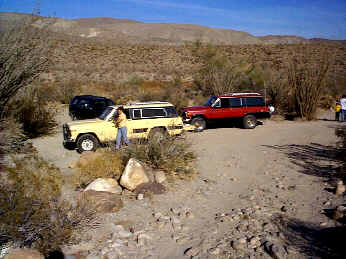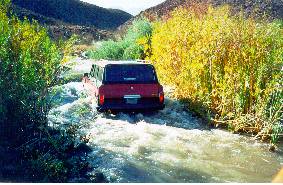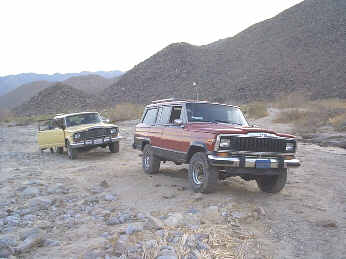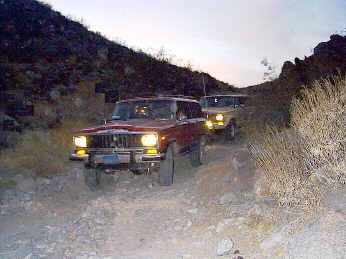
These are two our rigs - Pete Griffith's '82 Model 18 four- door Cherokee (red) , and mine - '79 Model 17 2-door wide track Cherokee (yellow). |
The Lindsays' book "Anza Borrego Desert Region" mentiones this place
using the following words:
"Only highly skilled and experienced drivers..." "There may be more brutal jeep traverses in that great desert, but the authors know of none." How's that? Too good I didn't read that particular part of the book before going up. The trail begins a few miles from Borrego Springs' Christmas Circle, and a park ranger checks your permit (yes, gotta shell out $5 for the fun - or, rather, $50 for a yearly permit). It is highly advisable to air down to 15-20 psi. The washboard will shake your teeth out; guess there are some die-hards in brand-new trucks who skip that part. Oh well, let's assume their trucks are leased or rented. |

Here's Pete's Chero going through the only year- round stream in Anza-Borrego desert. |
Pete dove first, made a nice wake, bounced a couple of times on the rocks, and made it through no problem. I figured that there was nothing in his 3" lift that could give him any advantage (at this point), and seconded the motion. The shame is that nobody really bothered to take any pictures, so our photo archive on that trip is very scarce. The Bronco followed. Here, we were at the point I wasn't considering going past, and stopped for a quick tailgate lunch to make kids and puppy happy. Some time later, a very nice gentleman asked us to pull our rigs somewhat apart so he could drive is Pathfinder out. He admitted being quite thrilled by the creek crossing. Polite as we are, we said a couple compliments on how good Nissan four-bys are. |

That's me behind the steer - see? |
I went up first. It wasn't really that "brutal" in that traverse; but some skill or at least reasonable action were a plus. Some of the rocks were indeed of a size of a 31" tire, and some nicely placed by Mother Nature where the pumpkins were to follow. Obviously, the same trail would take much more mojo and clutch wear if we had manual. Most of the time I stayed on brakes heavier than on gas, and that - going up. A couple of times I slammed the gas tank skidplate against the rocks, causing gas to squirt out and the audience to yell. Once I even ventured out of the truck to see if no rocks are sticking through the skid plate, but - good 'ole jeep was built for that kind of abuse. |
| We didn't know that the Upper Willows portion of the trail is closed on 1/1/96, a while ago, and it wasn't marked in any of the maps or books we had. So, it is advisable to check the trail conditions and closures with park rangers. Oh well. Sheep Canyon is a beautiful terrain, with plenty of trees - desert willows neighboring with palm trees and all kind of brush you find in that desert. There's Coyote Creek running year-round, and probably plenty of wildlife. It makes a very good camping place; a campground is located in west side of the Sheep Canyon. Many hiking trails originate there, and go up Salvador Canyon and others. |  |
 |
Still, came to the squeeze at 5:10, not very dark, but requiring headlights. Here fog lights came handy - unlike the headlights, they lit the area right next to your front overhang, making choosing the line a lot easier. The descent was no drama at all, requiring mostly little different approaches. Here I found that our rigs are different - Pete Griffith has 6" narrower track AND differentials on the drivers' side. Didn't hit any rocks any hard, though, only made scary bangs with that hitch receiver. Now my spare tire can only be reclaimed using the hacksaw - the 5/8" bolt holding it on place is bent flush with the hitch :-) |